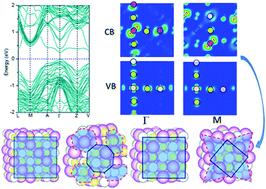当前位置:
X-MOL 学术
›
Nanoscale Adv.
›
论文详情
Our official English website, www.x-mol.net, welcomes your
feedback! (Note: you will need to create a separate account there.)
AgBiS2 as a low-cost and eco-friendly all-inorganic photovoltaic material: nanoscale morphology–property relationship
Nanoscale Advances ( IF 4.6 ) Pub Date : 2019/12/12 , DOI: 10.1039/c9na00505f Ming-Gang Ju 1 , Jun Dai 1 , Liang Ma 2 , Yuanyuan Zhou 3 , Xiao Cheng Zeng 1, 4
Nanoscale Advances ( IF 4.6 ) Pub Date : 2019/12/12 , DOI: 10.1039/c9na00505f Ming-Gang Ju 1 , Jun Dai 1 , Liang Ma 2 , Yuanyuan Zhou 3 , Xiao Cheng Zeng 1, 4
Affiliation

|
Solar cells made of low-cost solution-processed all-inorganic materials are a promising alternative to conventional solar cells made of high-temperature processed inorganic materials, especially because many high-temperature processed inorganic materials contain toxic element(s) such as lead or cadmium (e.g., CsPbI3 perovskite, PbS, CdTe and CdS(Se)). AgBiS2 nanocrystals, consisting of earth-abundant elements but without lead and cadmium, have already emerged as a promising candidate in high-performance solar cells. However, the nanoscale morphology–optoelectronic property relationship for AgBiS2 nanocrystals is still largely unknown. Herein, we investigate the electronic properties of various AgBiS2 nanocrystals by using first-principles computation. We show that the optoelectronic properties of bulk AgBiS2 are highly dependent on the M–S–M–S– (M: Ag or Bi) orderings. Moreover, because Ag–S–Ag–S– and Bi–S–Bi–S– in AgBiS2 bulk crystals contribute respectively to the valence band maximum and conduction band minimum, these unique chemical orderings actually benefit easy separation of mobile electrons and holes for photovoltaic application. More importantly, we find that AgBiS2 nanocrystals (NCs) can exhibit markedly different optoelectronic properties, depending on their stoichiometry. NCs with minor off-stoichiometry give rise to mid-gap states, whereas NCs with substantial off-stoichiometry give rise to many deep defect states in the band gap, and some NCs even show metallic-like electronic behavior. We also find that the deep-defect states can be removed through ligand passivation with optimal coverage. The new insights into the nanoscale morphology–optoelectronic property relationship offer a rational design strategy to engineer the band alignment of AgBiS2 NC layers while addressing some known challenging issues inherent in all-inorganic photovoltaic materials.
中文翻译:

AgBiS2 作为低成本和环保的全无机光伏材料:纳米级形态-性能关系
由低成本溶液处理的全无机材料制成的太阳能电池是由高温处理的无机材料制成的传统太阳能电池的有前途的替代品,特别是因为许多高温处理的无机材料含有有毒元素,例如铅或镉(例如,CsPbI 3钙钛矿、PbS、CdTe 和 CdS(Se))。AgBiS 2纳米晶体由地球上丰富的元素组成,但不含铅和镉,已成为高性能太阳能电池的有希望的候选者。然而,AgBiS 2纳米晶体的纳米级形态-光电特性关系在很大程度上仍是未知的。在此,我们研究了各种 AgBiS 2的电子特性使用第一性原理计算的纳米晶体。我们表明块状 AgBiS 2的光电特性高度依赖于 M-S-M-S-(M:Ag 或 Bi)排序。此外,由于 AgBiS 2块状晶体中的 Ag-S-Ag-S- 和 Bi-S-Bi-S-分别有助于价带最大值和导带最小值,这些独特的化学排序实际上有利于移动电子和空穴的轻松分离用于光伏应用。更重要的是,我们发现 AgBiS 2纳米晶体(NCs)可以表现出明显不同的光电特性,这取决于它们的化学计量。具有较小非化学计量比的 NCs 会产生中能隙状态,而具有大量非化学计量比的 NCs 会在带隙中产生许多深缺陷态,一些 NCs 甚至表现出类似金属的电子行为。我们还发现,可以通过具有最佳覆盖率的配体钝化来去除深度缺陷状态。对纳米级形态-光电特性关系的新见解为设计 AgBiS 2 NC 层的能带排列提供了一种合理的设计策略,同时解决了全无机光伏材料中固有的一些已知具有挑战性的问题。
更新日期:2020-02-19
中文翻译:

AgBiS2 作为低成本和环保的全无机光伏材料:纳米级形态-性能关系
由低成本溶液处理的全无机材料制成的太阳能电池是由高温处理的无机材料制成的传统太阳能电池的有前途的替代品,特别是因为许多高温处理的无机材料含有有毒元素,例如铅或镉(例如,CsPbI 3钙钛矿、PbS、CdTe 和 CdS(Se))。AgBiS 2纳米晶体由地球上丰富的元素组成,但不含铅和镉,已成为高性能太阳能电池的有希望的候选者。然而,AgBiS 2纳米晶体的纳米级形态-光电特性关系在很大程度上仍是未知的。在此,我们研究了各种 AgBiS 2的电子特性使用第一性原理计算的纳米晶体。我们表明块状 AgBiS 2的光电特性高度依赖于 M-S-M-S-(M:Ag 或 Bi)排序。此外,由于 AgBiS 2块状晶体中的 Ag-S-Ag-S- 和 Bi-S-Bi-S-分别有助于价带最大值和导带最小值,这些独特的化学排序实际上有利于移动电子和空穴的轻松分离用于光伏应用。更重要的是,我们发现 AgBiS 2纳米晶体(NCs)可以表现出明显不同的光电特性,这取决于它们的化学计量。具有较小非化学计量比的 NCs 会产生中能隙状态,而具有大量非化学计量比的 NCs 会在带隙中产生许多深缺陷态,一些 NCs 甚至表现出类似金属的电子行为。我们还发现,可以通过具有最佳覆盖率的配体钝化来去除深度缺陷状态。对纳米级形态-光电特性关系的新见解为设计 AgBiS 2 NC 层的能带排列提供了一种合理的设计策略,同时解决了全无机光伏材料中固有的一些已知具有挑战性的问题。











































 京公网安备 11010802027423号
京公网安备 11010802027423号